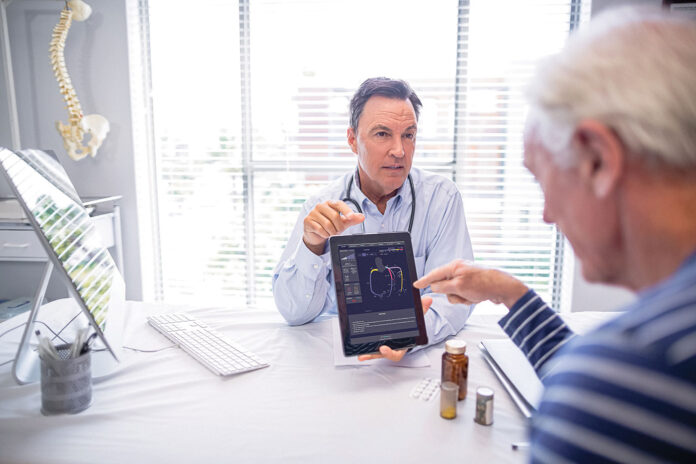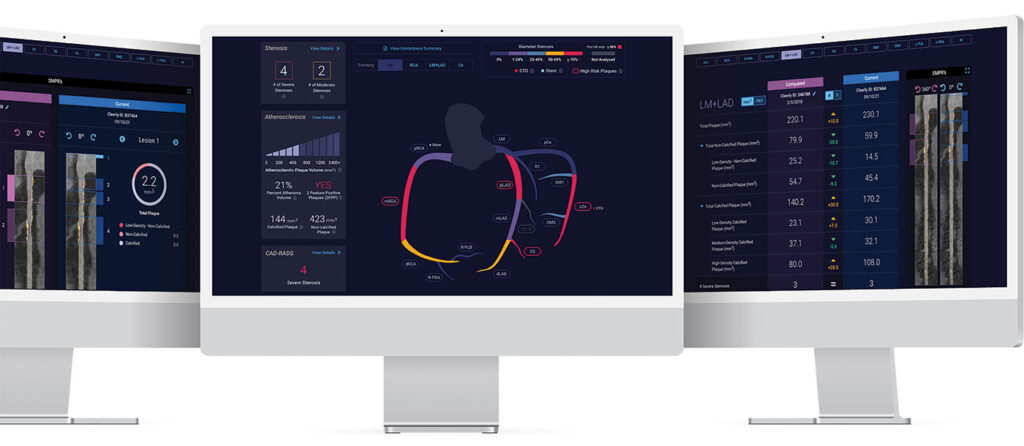
Already a popular topic, the launch of the large language model-based chatbot, ChatGPT, at the end of 2022 increased excitement around artificial intelligence (AI) in the media to fever pitch. This event triggered many heated debates about the technology and its numerous potential applications over the past 12 months.
There is no doubt that whatever your stance on its safety, AI has much to offer the hardworking clinician or biomedical researcher, particularly in the field of diagnostics and disease risk prediction. Significant advances in the technology, including improvements in large language models (LLMs) and image recognition algorithms, have created many possible use cases that range from speeding up hospital administration to triaging patients and diagnosing diseases like cancer.
Radiologists and pathologists have been some of the quickest specialists to harness the benefits of AI, developing four AI-based imaging tools that achieved FDA approval in 2018. One of these was an AI-based device made by IDx, which could detect diabetic retinopathy. The approval of the first AI-based software to detect prostate cancer, produced by Paige.ai, soon followed in 2021. A survey published the same year suggested that 30% of radiologists were already using AI in their clinical practice in 2020 and that 20% more planned to follow suit in the near future.

Chief Scientific Officer, Cleerly
Udo Hoffmann is the chief scientific officer of AI-focused medtech company Cleerly, which focuses on imaging and cardiovascular disease. Prior to starting at Cleerly, Hoffman worked as a senior radiologist at Massachusetts General Hospital and Harvard Medical School.
“Imaging in general is a very data heavy field … a report for a cardiac computerized tomography (CT) scan used to be half a page and 20 years later it’s six or seven pages, because there’s 20 to 30 quantitative measures that are now used. It’s impossible to keep that up based on manual labor,” he explained. “I remember around six years ago there was a wave of people going around saying your jobs are going to be in danger with AI. I was always thinking that without AI we’re going to be doomed because there’s no way we can actually do the workload.”
The use of AI-based medical imaging software for disease diagnostics has increased dramatically in the last few years and continues to become more and more innovative, but it is not the only area in healthcare making use of the potential of AI. The technology is also being used to aid the prediction of disease risk and guide clinicians on whether specific treatments will work for their patients.

Since the sequencing of the human genome, genomics has advanced in leaps and bounds. Reductions in the cost of the technology have allowed whole genome sequencing to become a feasible option for use in the clinic, such as for diagnosing children with rare diseases. Polygenic risk scores are also being developed to aid the prediction of cancers and other complex diseases. Researchers and companies are now using AI to make genomic risk prediction more accurate and efficient and to help democratize genetic medicine.
AI-optimized imaging for better patient outcomes
Denver-based Cleerly analyzes coronary computed tomography angiography (CCTA) images to accurately assess the prognosis of people with atherosclerosis. The company’s technology quickly and non-invasively assesses the extent of coronary artery disease in at-risk individuals to determine the best possible treatment for their condition.
“Our output includes all the standard measures of coronary disease that are used for medical decision making, such as stenosis, but also provides a lot more insight into coronary atherosclerosis as a disease that causes most heart attacks,” said Hoffmann.
In November 2023, Cleerly announced that it would be testing its technology in the TRANSFORM trial. The trial aims to recruit 7,500 people with prediabetes, type 2 diabetes, or metabolic syndrome and no symptoms of heart disease to assess the health of their coronary arteries and prescribe personalized treatments or lifestyle measures based on their results.

“We’ve proven that these tools are accurate, but now we want to show if they lead to an improvement in health outcomes,” said Hoffmann.
“The TRANSFORM trial is our flagship trial… If successful, it has the potential to really change the paradigm of primary prevention for heart attacks.”
Brainomix began as a spinout from the University of Oxford in 2010 and, like Cleerly, has a focus on AI-based imaging analysis to aid treatment of stroke. It was an early company in the field of AI and healthcare and has made the most of its early start by achieving wide adoption of its technology in the U.K. and many European countries. It recently achieved FDA approval for its stroke technology in 2023 and is expanding its operations and customer base in the U.S.
To ensure the best chance of a good outcome, speedy treatment is crucial for stroke patients. Brainomix has a technology called e-Stroke, which uses AI to quickly analyze CT or magnetic resonance imaging (MRI) brain scans of stroke patients and send automatic alerts to doctors to let them know which patients would benefit most from thrombectomy or other treatments.

CEO and Co-Founder, Brainomix
“We have shown that hospitals that are using our technology are trebling the number of patients that have a good outcome after a stroke,” commented Michalis Papadakis, CEO and co-founder of Brainomix.
“We increased by up to 55% the number of patients getting either endovascular treatment, mechanical thrombectomy, or clot-busting thrombolytic treatment.”
The company is now developing a second indication for its technology in patients with lung fibrosis. “There is a similar unmet need as in stroke in the sense that it’s another devastating condition,” noted Papadakis, “patients have a life expectancy of three to five years, which is worse than most cancers. Despite this, it takes up to two years until they’re diagnosed.”
French-American AI company Owkin is taking a somewhat different approach. It is aiming to use AI to discover targets, develop new drugs, and diagnose different diseases, with a focus on cancer. It combines an imaging approach with genetic analysis to achieve its goal.
Microsatellite instability (MSI) occurs in certain tumors and is caused by a faulty DNA mismatch repair system. Around 15% of patients with colorectal cancer have MSI and it is also seen in Lynch syndrome, an inherited predisposition to colorectal cancer.

Chief Research and Development Officer
Owkin
“Typically, you have a patient with a cancer, take a biopsy and you get an image. Usually, if there is a suspicion that the patient may be eligible for immunotherapy then we do a genomic test to check if the patient has a genomic feature called MSI,” explained Jean-Philippe Vert, chief research and development officer at Owkin.
“What we have developed is a system that correlates the image to the genetics, so now we can have a prediction of genomic instability from the image. This is a very fast and cheap way to screen patients.”
The company published a paper in November last year validating this technology, MSIntuit, in patients with colorectal cancer. Although genomic testing is accurate, it is time consuming and more expensive than histological screening. Owkin’s method allows targeted treatment while reducing the cost and time associated with large-scale genomic screening.
Owkin recently signed a deal with MSD to develop its diagnostic technology further. “MSD has a fantastic drug called Keytruda that really saves many lives, and which is already given in many indications. But there are some cancers, including ones we are going to collaborate with them on, for which Keytruda is not usually given, because we know that only a small number of patients are likely to be eligible,” said Vert.
“If we have a test that costs nothing once you have the image, then you can preselect a subset of patients who may be eligible and then do the genetic tests in that group.”
Improving genetic predictions using AI
While Owkin is using imaging to predict genomic status of patients, other companies and researchers are combining AI and genetic analysis more directly.

Vice President of AI, Illumina
Kyle Farh leads sequencing giant Illumina’s AI division. He and his team have created an AI-based software program called PrimateAI-3D, which is able to accurately predict disease-causing mutations in humans.
PrimateAI-3D uses technology similar to ChatGPT and natural selection principles to predict human disease-linked variants based on genomic sequence of 233 different primate species.
“What we’ve done is trained a neural network using information about what variants are acceptable by natural selection, using a large amount of data for non-human primates. That information has helped train a network that is state of the art for interpreting which variants cause disease,” noted Farh.
“We’ve been able to show that the method is state of the art for polygenic risk score (PRS) prediction of things like dyslipidemia and type 2 diabetes. It performs better than the existing PRS algorithms at identifying who’s at greatest risk. Even more importantly, it also doesn’t have the same kind of ancestry biases, as the original polygenic risk scores so they work equally well in Europeans and non-Europeans.”

Director, Institute for Molecular Medicine Finland,(FIMM), University of Helsinki
When people undergo genetic testing, usually to search for possible genetic disease, so-called “variants of unknown significance” (VUSs) can be difficult to interpret. “I think what we’ll see over the next five years is that the problem of VUSs is going to be largely solved by machine learning approaches,” added Farh.
On the academic side of things, the INTERVENE Project is an international consortium set up to “develop and implement next-generation tools for AI-facilitated personalized medicine,” initially over a five-year period. Led by Samuli Ripatti, PhD, and Andrea Ganna, PhD, both based at the Institute for Molecular Medicine in Finland at the University of Helsinki, the project aims to develop methods to improve genetic risk scores using AI.
Its goals are to analyze, combine, and harmonize large datasets of genetic information like the FinnGen biobank, develop new AI-based tools for use in genomics (such as the IGS4EU platform proposed for creation of PRSs in the U.K.), and test any new PRSs in large population cohorts.
“We went from considering maybe five to 10 genetic variants … and building a polygenic score with that, to essentially including the entire genome,” said Ganna.

Associate Professor, Health Data Science
Finland,(FIMM), University of Helsinki
“AI has revolutionized the field. It’s not that now we can predict [exactly] when people will get cancer or cardiovascular disease… But it makes everything easier in the sense that you can train a massive model to learn the structure of the data.”
Both Ganna and Ripatti advocate developing AI-based prediction models that include both polygenic markers and other lifestyle factors to improve disease risk prediction.
“We really need to get these two worlds together… Combining the genetic factors and non-genetic risk factors is where there is clearly room for algorithmic development,” noted Ripatti.
He added that interaction between single nucleotide polymorphisms (SNPs) can also be measured more easily with AI. “Traditional PRSs have been additive in statistical terms. We assume that each single nucleotide polymorphism contributes only in an additive way and that there are no interactions between SNPs. That’s where AI can bring additional value by allowing SNPs to also interact with each other,” explained Ripatti.

CEO and Co-Founder
Nucleome Therapeutics
PRSs are more complex than they were, but the overall idea is not new. In contrast, U.K.-based Nucleome Therapeutics and its CEO and co-founder Danuta Jeziorska are tackling a new area of genomics using AI, namely the “dark genome.”
The non-coding or “dark” part of the genome comprises 98% of the DNA. It is now believed that around 90% of disease-associated genetic variants are also located in non-coding DNA, but until recently, these have been hard to locate.
Nucleome’s machine-learning assisted technology allows it to analyze variation in the non-coding regions of the genome and uncover links to disease. It plans to collect data on disease-associated genetic variants in the dark genome and use this information to develop new therapeutics for diseases such as lupus erythematosus and rheumatoid arthritis.
“At the moment, what we’re using machine learning for is to predict which variants are causal,” said Jeziorska.
“The first challenge is to find out which variants are really disease causing. The next challenge is that because non-coding variants impact gene regulation, their activity is cell type specific. This means if you look in the wrong cell type, you’re completely going to miss the activity… Finally, you need to find out which gene is impacted. Genetic variants in this region can be close or far away from the gene they regulate.”
To the future and beyond
It certainly seems as if AI as a tool for diagnostics and disease prediction is not going away any time soon, but in such a fast-changing field it is hard to predict what the future holds. As competition heats up in the medical AI space, companies are beginning to diversify and develop more than one type of technology like imaging algorithms and LLMs, or develop models that include many factors such as genomic data and clinical features.

“The more we combine these biomarkers and use and develop very sophisticated AI models that integrate these different levels of information, the more powerful the biomarkers are and the more personalized they are for the specific patient,” said Papadakis.
There seems to be a lot of potential for AI to improve genetic disease prediction and genomics, which companies like Illumina are keen to exploit.
“I think what’s particularly exciting about applying AI to genomics, is that unlike an application like ChatGPT, where AI can emulate human language using natural human text as its teacher, the information in the genome is something which humans have no ability to read or interpret directly. It’s something that we hope machines can really take the lead on to find connections that will be useful for health care,” said Farh, who is also excited about the potential for democratizing genetic disease risk analysis and removing ancestry biases present in many biobanks and older genome-wide association studies.
One issue that companies in this space are encountering in the face of increasing competition is how best to showcase their technology to hospitals and clinics that might want to use it.
“I was working for Stanford for a little bit. The conundrum was that they had about 60 companies that produced an imaging algorithm that might be useful, and the clinicians were interested, but the department there was faced with the reality that they didn’t have the resources to evaluate all 60 companies,” explained Hoffmann.
Several players have now emerged to try and solve this issue, such as VISAI and AiDot. These companies act as a kind of middleman or app store for AI products and technology. “These companies will serve a vital role to bring AI to the users,” added Hoffmann.

Another factor that can make an AI algorithm or model stand out is the quality of the data used to train it. “Not only does the data have to be good, but as soon as you develop products, there’s lots of work to validate them,” noted Vert.
More countries and regions are now beginning to crack down on the use of AI. Late last year all 27 countries in the European Union came to a historic agreement on proposed content for the first EU Artificial Intelligence Act, which should become law in a couple of years.
This act covers all AI, not just that used in healthcare. While many are keen for the act to come into force to prevent malpractice, others are concerned it may stifle innovation or drive such companies to move to other countries with lower levels of regulation. It remains to be seen if the act will have a positive or negative impact on the AI research and tech community.
Read more:
- 2020 ACR Data Science Institute Artificial Intelligence Survey, August 2021
- FDA backs clinician-free AI imaging diagnostic tools, August 2018
- Independent real-world application of a clinical-grade automated prostate cancer detection system, April 2021
- Cleerly, Partners Announce TRANSFORM Trial to Evaluate Personalized Heart Disease Care Strategies at AHA 2023, November 2023
- Brainomix Receives FDA Clearance for Its Flagship Stroke AI Imaging Software, March 2023
- Validation of MSIntuit as an AI-based pre-screening tool for MSI detection from colorectal cancer histology slides, November 2023
- Identification of constrained sequence elements across 239 primate genomes, November 2023
- Illumina unveils AI software to predict disease-causing genetic mutations in patients, June 2023
- Intervene Project
- FinnGen website
- The EU Artificial Intelligence Act webpage
Helen Albert is senior editor at Inside Precision Medicine and a freelance science journalist. Prior to going freelance, she was editor-in-chief at Labiotech, an English-language, digital publication based in Berlin focusing on the European biotech industry. Before moving to Germany, she worked at a range of different science and health-focused publications in London. She was editor of The Biochemist magazine and blog, but also worked as a senior reporter at Springer Nature’s medwireNews for a number of years, as well as freelancing for various international publications. She has written for New Scientist, Chemistry World, Biodesigned, The BMJ, Forbes, Science Business, Cosmos magazine, and GEN. Helen has
academic degrees in genetics and anthropology, and also spent some time early in her career working at the Sanger Institute in Cambridge before deciding to move into journalism.


